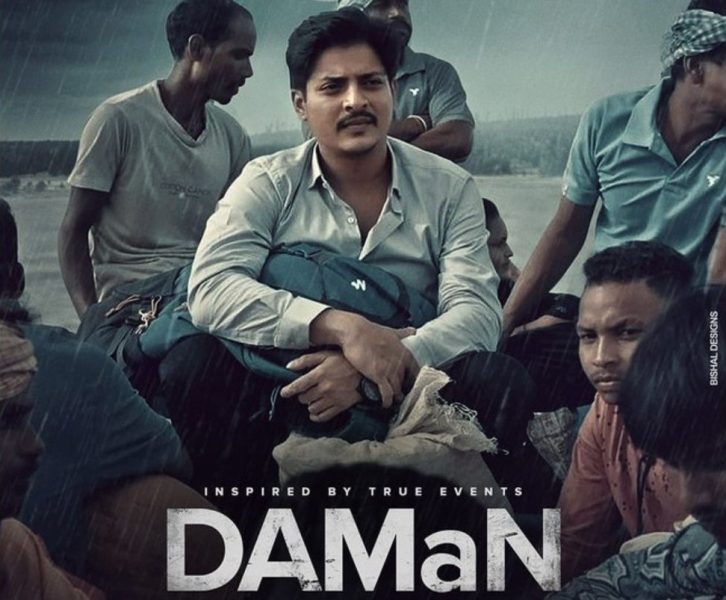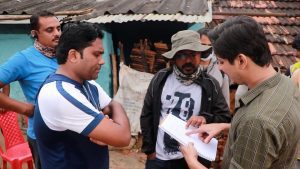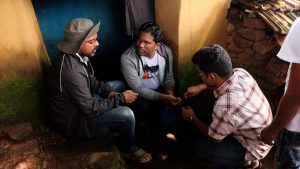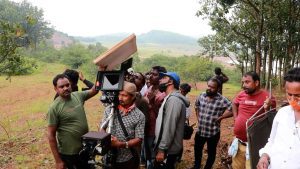
Not just 'Kantara', Odia film 'Daman' is making waves nationwide. Meet the directors

It is not just regional films like Kantara and KGF that are stirring up interest nationwide and breaking the glass ceiling in Indian cinema. Giving them a tough contest is an Odia film named Daman, which has topped the popularity charts, clinching an IMDb rating of 9.3 and surpassing even southern favs Kantara (8.8) and KGF (8.4).
It is ironic that just a couple of years ago, when the makers of Daman approached producers with their script, they were laughed at and asked if the “villagers, the labourers and the auto-rickshaw wallas,” the so-called target audience of the Odia film industry, would watch a movie that doesn’t have a heroine, a villain and romance. Today, the movie is credited for being a cinematic masterpiece and heralding a new era for Odia films.
Daman, an acronym for Durgama Anchalare Malaria Nirakarana (Malaria Control in Inaccessible Areas) was released across 55 theatres in Odisha and 15 across Chennai, Bengaluru, Mumbai, Delhi, Kolkata, Ahmedabad, Surat, Pune and Hyderabad – a feat no contemporary Odia film has achieved so far and is still running in several theatres. The Odisha government also made the film tax-free and ordered it to be screened in all districts of the state.
The film has been written and directed by Debi Prasad Lenka, a former editor, and Vishal Mourya, an engineer-turned-filmmaker. Starring Odia superstar Babushaan Mohanty and Dipanwit Dashmohapatra in the lead, Daman is the story of a lone doctor’s fight against nature, disease and superstition to save 151 marooned tribal villages in an Odisha village from the deathly onslaught of malaria.

Made on a shoestring budget of around ₹95 lakh, Daman has raked in over ₹4 crore in the five weeks of its release. The overwhelming response it has received has prompted the makers to dub the film in Hindi. The Hindi version will be released in December or January.
Vishal, a director, and Debi, an editor, met in 2010 when both were working for Femina Miss India in Mumbai. They immediately bonded over their passion for fresh scripts and worked together on several projects, including government documentaries and commercial films like B-for Bundelkhand (a yet-to-be-released Hindi film) and Biju Babu (Odia) and briefly dabbled in YouTube before finally making Daman.
The Federal caught up with the director-duo Vishal Maurya and Debi Prasad Lenka, to understand why regional films are the flavour of the season, Daman’s comparison with Kantara and why the film’s success is a watershed moment for the Odia film industry. Excerpts from the interview:
Isn’t Daman a daring venture, considering the kind of content the average Odia filmgoer consumes?
VISHAL: We believe the audience does not harbour this mindset that a film with a social message and without a heroine, a villain and love songs will be a commercial dud. This is the opinion of the people who run the industry here. Daman itself is proof that if your content is original, then people will flock to the theatres to watch it.
Take the case of the Kerala and Punjab film industries. The population in these states is fewer than Odisha, but their films do way better. Why? Because they work with original scripts. In Odisha, filmmakers struggle to make films worth ₹20 lakh because only a few are interested in watching a cheap, badly-made rip-off of a multi-crore south Indian blockbuster.
We wanted Daman to be raw and original at an affordable budget. The goal was clear – it’s fine if “villagers” don’t like it, let the doctors at least watch it.
What’s your inspiration behind making Daman?
VISHAL: It is inspired by an Odisha government scheme for malaria eradication in eight tribal districts. In 2020, when we went to shoot a documentary in Malkangiri district, we were impressed by the collective efforts of the government officials, including ASHA workers, Anganwadi workers, forest officials and police, in the malaria eradication programme.
Also Read: Veteran Odia film actress Jharana Das dies at 77
As shown in the film, these officials had actually trekked to 151 villages, rang bells, used microphones and personally checked houses to ensure people used mosquito nets. Daman is not a biopic, but a tribute to all these government employees, these unsung heroes who are often portrayed in a poor light in popular media.
Daman has finally made the Odia film industry visible to the world. But, what challenges does the industry face?
DEBI: Crab mentality. There is a constant attempt by producers in Odisha to chop a director’s creative wings. In 2018, when I came to Odisha from Mumbai, the industry was in a terrible state. The films were being called “super-duper hits,” but the producers struggled to break even.
I was brimming with ideas. But when I approached producers, all they wanted me to do was to slightly tweak a particular south Indian movie to make an Odia film. When I pitched original scripts, I was asked if the “people beyond Chandikhole would watch it”. Daman has proved that producers should take the leap and have faith in original scripts and the director. We were fortunate to have Deependra Samal, who knew what exactly the project needed and gave us constructive feedback.
What has worked for Daman?
DEBI: It always is a mix of a good product and publicity. We had a strong script and I believe if the writing is good, half the battle is won. Everything, from how a character would speak, sit and emote, was written in the script. We wanted zero confusion on the set.
The only time we revised the script was at a 15-day workshop we held with actors. It is here that we got the tribal parts of the dialogues translated.
We didn’t have the budget for publicity. But, luckily for us, it was the audience who spread the word. Well-known YouTubers and Intagrammers gave us rave reviews, increasing the film reach outside Odisha. In fact, a lot of Odia audiences mailed and sent DMs to reviewers, almost pestering them to watch and review the film.
The film had a pan-India release, an unprecedented achievement for a contemporary Odia film. Did you anticipate it?
DEBI: It was completely unexpected and happened organically. Initially, when we wanted to release the film in June, we were offered only 15 theatres. We had to stall the release at least twice as it clashed with big-budget Hindi and masala Odia films.
Also Read: The big battle to get small regional films released on OTT
The film instantly appealed to audiences when it was released across 44 Odisha theatres on November 4, prompting more theatres to screen it. Bhubaneswar theatres alone screened 22 shows on the second day, followed by 30 shows on the third day. The capital screened 32 shows in the third week of the film and in the fourth week around 55 theatres were showing the film across the state.
In several places, film halls that were shuttered had to be reopened following a raging demand for tickets. As its popularity spread, we started getting requests from theatres across prominent Indian cities to screen the film. Daman ran housefuls in Hyderabad, Chennai and Bengaluru for three consecutive days.
On casting Odia superstar Babushaan and tribal artistes…
VISHAL: Who else but Babushaan? We knew that the casting had to be realistic. Babushaan perfectly fit the bill – he had the age and the innocence of a freshly passed-out MBBS student. We wanted the rest of the cast who played the tribals, the health staff and the Maoists to act naturally.

Several theatre artistes of the Koraput Cultural Society were roped in for the film. Debi and I went to Sunabeda 15 days ahead of the shoot to do a workshop with them. Many of these artists were employees of Hindustan Aeronautics Limited, Sunabeda and every day they would take the dialogues to their office to learn them.

The songs in the film use rare Odia words. Was it a conscious decision not to adulterate the language with unnecessary Hindi and English words as it has been done so far?
DEBI: We knew that any goof-up in the language would upset the Odia audience and from the beginning itself, we were very clear that the songs would not have any borrowed words from Hindi or English. JP Wordsmith, who has penned three of the four songs in the film, lived in Malkangiri and was the best person for the job.
What were the challenges you faced during the shoot?
VISHAL: The location itself was a challenge. We had set up a base camp, but then as shown in the film, we had to cross a river and ride uphill on muleback while carrying heavy equipment to go to the villages where we were supposed to shoot. Sometimes when we arrived, the tribals who had initially agreed to talk would flatly refuse, and we would have to scramble for a replacement.
The weather also often played spoilsport. Sometimes, we would catch the perfect light, only for a sudden spell of rain to ruin it and make us re-shoot the entire scene. As we shot in multiple villages, our first job would be to cajole a local to play translator between us and the tribals. Despite all these challenges, we managed to wrap up the shoot within 20 days.

The film is being compared with Rishab Shetty’s Kantara. Is it a fair comparison?
VISHAL: Odia film industry is very backward in terms of budget and screens. We have barely 50 screens, while other states have over 2,500. The first Odia film was made way back in 1936, but the industry sadly has failed to grow at the same pace as other regional industries. But despite that, if people compare our product with successful industries, it is definitely a victory.
Also Read: 2022: The year the tide turned in favour of Kannada film industry
Your response to the criticism that certain scenes in the film resemble Shah Rukh Khan’s Swades and web series Panchayat…
DEBI: No one says the same thing for a Bollywood or a South Indian film. For so long, we have been copying from other industries that it is only natural for the audience to suspect us, even when we make original content.
If you are talking about similarities in Babushaan’s boat scene with that of SRK’s in Swades, a close shot of a man in a crowded boat will look the same anywhere you shoot it. And to be honest, we had no reference point, not even the films of the 70s, 80s or 90s when the Odia industry was churning out good content, as we didn’t want anything to influence our product.
There is a new appetite for regional films. Can the Odia industry keep up?
VISHAL: Film-making is all about storytelling. Regional language films are a treasure trove of stories, folklores, biopics and locations and we don’t have to look anywhere else if we want original, unadulterated content. Also, as an industry, we need to understand that making a remake is very different from copy-pasting.
Regional filmmakers have to understand that the language barrier is broken and content is now going global. There is an increased interest in regional Indian films in Europe and South Asian nations such as Japan and China. The Odia film industry should tap into that potential. What matters the most is your story and how you present it. People across the world are ready to watch your film with subtitles if your story is unique and engaging. We won’t survive if we don’t keep up.


